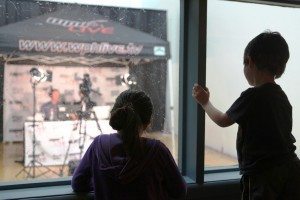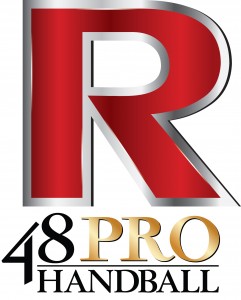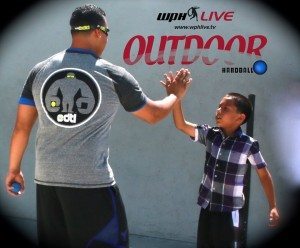![Why_Donate_pic]() WHERE TO PLAY?
WHERE TO PLAY?
Handball is played all over the world and to rank and file each club location, player and address is a task. However, the United States Handball Association, GAA Handball (Ireland), Canadian Handball Association and World Players of Handball, to name just a few, have unlimited resources and connections in almost all parts of the globe. Please contact us for questions on where to play and how to play and the rules of the game: Email Us – wph@race4eight.com
RULES OF PLAY
The Governing Body of Handball, the United States Handball Association, has compiled a full list of official rules. For more, Go HERE>
HANDBALL HISTORY
Source: Ralph Hickok, author of The Encyclopedia of North American Sports History
Beginnings in Ireland
Almost all modern racket sports grew out of a form of handball, known as jeu de paume, which originated in France, probably during the 11th century. It’s possible that modern handball can also be traced to jeu de paume, but the sport as we know it was nurtured for centuries in Ireland and was brought to North America by Irish immigrants.
Handball, along with hurling, is woven into Irish myth and legend, as well as Irish history. Evidently, it was originally played outdoors. In 1527, Galway, in western Ireland, prohibited playing ball against the town’s walls.
At that time, handball was probably a one-wall game most of the time, though there may well have been three- and four-wall version. The ball was made of cloth, tightly rolled and wrapped in leather.
During the late 17th century, court tennis became something of a rage in London, and many courts were built. The rage died in the 18th century, though, and handball players took over some of the abandoned tennis courts. Most of them were probably immigrants from Ireland. The first great player, John Cavanagh, certainly was. When he died in 1819, William Hazlitt eulogized, “It is not likely that anyone will now see the game of handball played in its perfection for many years to come–for Cavanagh is dead and has not left his like behind him.”
Although played on an enclosed court with four walls, this version of handball was actually three-wall, because the court was more than 100 feet long, putting the back wall effectively out of play.
The idea of three-wall handball was brought back to Ireland by players returning to their native soil, and probably also by British soldiers and police.
In the meantime, a four-wall version of handball had developed independently in several English public schools, notably Eton, Rugby, and Winchester. This form of the sport was called fives, probably in reference to the hand as “a bunch of fives.” Fives courts were built at some schools and at least one college in Ireland during the first half of the 19th century, and may have influenced the development of four-wall Irish handball.
Handball in the U. S.
Irish immigrants brought handball to Australia, South Africa, and North America. The Shamrock Saloon and Ball Alley, listed in the San Francisco City Directory of 1851, has been described as the first known handball court in the United States. It was common in Ireland for a pub to have an adjacent handball alley, with one of the pub walls used as the front wall of a three-wall court, but the one-wall game was also often played in an alley. It’s not known which sort of alley this was.
It is known, though, that Phil Casey built a genuine handball court in Brooklyn in 1882.
Casey had emigrated from Ireland in 1872. He and fellow immigrants tried playing in alleys, but weren’t happy about it because most walls were made of brick. So he raised the money to build a four-wall court, 33 feet long, with a front wall made of brick faced with marble and the other walls of cement.
Casey’s court was so successful that he built others with his profits. He also became the sport’s first world champion. After defeating another Irish immigrant, Bernard McQuade, for the American title in 1887, Casey challenged the Irish national champion, John Lawlor, to a contest for the world championship and a purse of $1,000.
The first 10 games of the match were played in Cork, Ireland, at Lawlor’s home court and the last 11 were at Casey’s Brooklyn court, with the title and prize money going to the player who won 11 games. Lawlor won 6 of 10 in Ireland, but Casey then took 7 in a row at home to win the championship. Casey then took on, and beat, all challengers until he retired in 1900.
Handball gained popularity in and around New York because of Casey, but the Amateur Athletic Union (AAU) and the YMCA were mainly responsible for its growth in the rest of the country.
The AAU codified rules and held a tournament to determine the national amateur championship in 1897. Although there wasn’t another national tournament until 1919, the AAU rules prevailed with member athletic clubs.
Handball courts were included in most of the YMCAs built in the 1890s and the early part of the 20th century. The YMCA drew up a set of rules that were somewhat different from the AAU’s and held its first national tournament in 1925.
Not only were the rules different from one organization to the other, but two different types of balls were used in different places. The ball developed for American play was a bit larger and somewhat softer than the ball used in Ireland, but some American courts used the Irish ball. From 1924 through 1938, the AAU held national tournaments for both hardball and softball, but the hardball competition was discontinued in 1939 and the softball became more or less standard.
Unhappy with AAU supervision, a group of players led by Bob Kendler of Chicago formed the Amateur Handball Union in 1951. It became known as the U. S. Handball Association (USHA) the following year. The USHA and AAU had an uneasy partnership for several years. The two organizations began holding a joint national championship tournament in 1952.
Meanwhile, the YMCA had begun hold its own national tournaments in 1925. In 1958, the three groups agreed on common rules and held a single tournament.
But the USHA broke away again in 1961, mainly to allow professionals in other sports to compete as amateurs, which was against AAU rules. Since 1978, the USHA has been the sole governing body for handball. The association says there are about 2.5 million players using about 1,000 public and 2,000 private courts in North America.
The Rebirth of One-Wall
The original Irish game of one-wall handball had been pretty much abandoned along the way, but the one-wall version was ironically re-invented on South Brooklyn bathing beaches early in the 20th century.
It began on beaches that were protected against erosion by long wooden jetties. At low tide, when the side of a jetty was out of the water, bathers staged impromptu games using a worn tennis ball. Areas were marked out in the sand and several games were often going on simultaneously.
The first dedicated one-wall court was put up at Parkway Baths in 1909. It became so popiular that other beach clubs soon had their own courts. Other courts were built indoors by athletic clubs during the 1920s and New York City erected hundreds of outdoor courts in city parks during the 1930s.
The AAU staged a variety of city, metropolitan, and state tournaments, and finally a national tournament, all centered in the New York metropolitan area. Interest in one-wall handball declined after World War II, but in 1959 the USHA held its first national championship tournament. That increased competition and the championship has been held annually since then, with a two-year hiatus in 1975 and 1976.
US HANDBALL HALL OF FAME
History
The U. S. Handball Association established its hall of fame in 1954. There are two categories of inductees: players and contributors.
To be inducted, a player must be over 40 years of age and retired from serious competition for at least five years. Contributors are honored for outstanding service to the game on the national level.
The hall of fame is located in the USHA’s national headquarters in Tucson, Arizona. In addition to plaques honoring the inductees, it contains photographs, plaques, medals, trophies, and other memorabilia, as well as a library that includes tournament and instructional videos along with books. A Wall of Champions list winners of national one-, three-, and four-wall tournaments.
WORLD PLAYERS OF HANDBALL FOUNDATION
History
The World Players of Handball (WPH) was established in 2004 under the name World Pro Handball League (WPHL) with sights on revitalizing a pro handball tour. The WPHL used innovative and progressive marketing approaches to expose handball to mass audiences, to include, filming and webcasting LIVE handball matches all over the world.
In 2005, the WPHL filmed the USHA 1 Wall Nationals months after the Big “C” Showdown in Concord, California, followed by the Casey Lawlor Cup. But in 2006, the WPHL and co-founder(s), Jeff Kastner & Dave Vincent, streamed the first ever LIVE handball feed from Seattle, Washington, at the WAC event, Show Time in Seattle, to rave reviews. This live webcast opened doors for the 2006 USHA 4 Wall Nationals, Simple Green US Open, World Championships, Canadian Nationals, Collegiate Nationals, Vegas 3 Wall Outdoor World Championships and many pro majors between 2006 to the current date. In fact, the WPH has filmed over 1,200 handball events, finding their niche in the process.
In 2009, the WPH regrouped and formed the World Players of Handball Foundation (formulating a 501c3 Non-Profit in the process); moving from Northern California to Tucson, AZ. The newly formed WPH, created a board of directors headed by USHA Hall of Fame member and Yes 2 Kids President, Fred Lewis; named David Vincent as the Executive Director and refocused energies on junior development, webcasting and marketing the sport of handball.
 In 2012, the WPH created an outdoor branch, labeled, “WPH-Outdoor,” headed by Membership Director, Ashley Moler. WPH Outdoor is based in Southern California and is designed to develop the outdoor game of handball in the hotbed of SoCal; offering tournament and support around the country.
In 2012, the WPH created an outdoor branch, labeled, “WPH-Outdoor,” headed by Membership Director, Ashley Moler. WPH Outdoor is based in Southern California and is designed to develop the outdoor game of handball in the hotbed of SoCal; offering tournament and support around the country.
In early 2013, Fred Lewis resigned as President and the WPH named David Fink as the Youth Donor and Development Director; alongside his assistant, Tracy Davis. Chairman, Charles Charvoz, was named and a new board of director look began to take place. With the Fink/Davis hire came a junior division called, “Junior WPH,” with a focus on growing the sport from the ground up.
By 2013, the WPH has created or been apart of six Made-for-TV specials to include the widely publicized Jake Plummer Handball Documentary on AT&T’s U-Verse channel, worked alongside NFL Films, ESPN, Yahoo Sports and Sports Illustrated, to name just a few. As the new year passed, the WPH film crew also passed it’s 50th LIVE webcasted tournament and is nearing it’s 1,500th filmed match. Videos on the WPH On-Demand page has long-since surpassed the 1,000,000 play mark, with more videos coming with each month.
Race For Eight
 The WPH along with Simple Green and sponsors created the first organized pro tour since 2004, when the highly successful Race4Eight Pro Handball Tour kicked off in 2011/12 [The WPH ran the pro tour from 2006-2011 w/out title sponsorship]. The Race4Eight is a series of stops where players gather points. The top eight point earners, after the last stop, is invited to the WPH Super Bowl, The Player’s Championship. Each stop has brought us qualifiers, elite players, junior/pro clinics, mounds of fans and gigantic numbers of webcast viewers. The WPH is entering it’s fifth season of the R48Pro; now including seniors and women’s elite (and being broadcast LIVE on ESPN).
The WPH along with Simple Green and sponsors created the first organized pro tour since 2004, when the highly successful Race4Eight Pro Handball Tour kicked off in 2011/12 [The WPH ran the pro tour from 2006-2011 w/out title sponsorship]. The Race4Eight is a series of stops where players gather points. The top eight point earners, after the last stop, is invited to the WPH Super Bowl, The Player’s Championship. Each stop has brought us qualifiers, elite players, junior/pro clinics, mounds of fans and gigantic numbers of webcast viewers. The WPH is entering it’s fifth season of the R48Pro; now including seniors and women’s elite (and being broadcast LIVE on ESPN).
The WPH has continued to develop major marketing opportunities with it’s cameras; like the widely publicized WPH/WOR 3 Wall Ball Outdoor World Championships along with World Outdoor Racquetball on the parking lot of the Stratosphere Hotel and Casino (annual event held in late September in Las Vegas, NV); or the East vs West Big Ball 1 Wall Challenge on the WPH Tucson 1 Wall Courts. WPH continues to film and webcast around the country and has been present for the USHA 4 Wall Nationals, US Open of Handball, USHA Collegiate Nationals, Irish Nationals, World Championships, Canadian Nationals, and Race4Eight Pro Series, to name just a few. Viewers catch all WPH handball matches (past and LIVE) at www.race4eight.com.
The WPH is member-driven, donor inspired and supported by it’s many, many, webcast viewers through WPH broadcast subscriptions. Viewers of the WPH broadcast page are able to watch past handball matches (on-demand) and future LIVE events with a paid fee.
Want even more history and results from the sport of handball?
Go HERE: https://wphlive.tv/category/elite-handball/the-history/
Pages:


